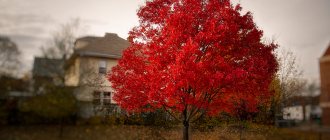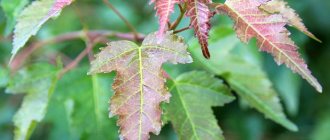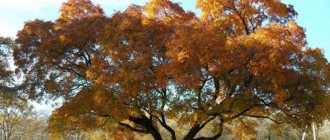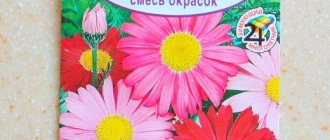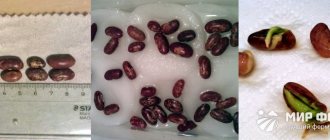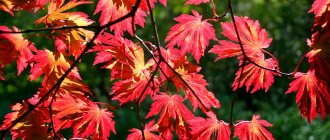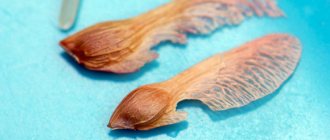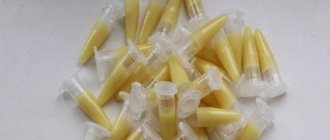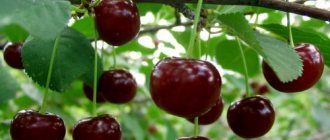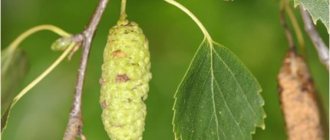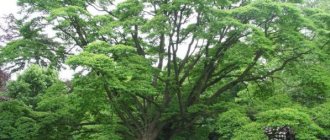09/10/2020 Scientist Cat Nature Maple plantings with spreading branches in parks and gardens are a common thing. Very little time has passed, and we already consider this species almost native. Maples decorate alleys and roadsides. They are planted on the territory of schools, kindergartens and other cultural and administrative institutions. Some time ago, few people thought about the dangers of this tree. Its beauty was striking, especially in autumn. What kind of tree is the ash maple? What are its benefits and harms for the environment and humans? Where is the species distributed? The answers to these questions are given in the article.
Historical information
Maple was brought to Europe at the end of the 17th century. It came to our country only a century later. Mature trees decorated the Botanical Garden in St. Petersburg. Samples were brought to us from the southern regions of the natural habitat of maples. In this regard, there were unsuccessful attempts to grow an alien plant in the Russian climate, and even in open ground. A lot of time passed and a tremendous amount of work was spent before breeders developed the ash-leaved maple. It has been successfully grown in various regions of our country. People liked this tree.
Growing maple from seeds
There are many types of maple in our country, so everyone can choose a suitable specimen even for a very modest-sized garden plot. It's nice to grow such a luxurious tree with your own hands. Moreover, it is not difficult to do this even for a beginner in gardening.
First of all, you need to decide what type of maple you want to grow. The thing is that not all varieties can be propagated by seeds - there are decorative forms that are propagated exclusively by grafting or cuttings.
For growing from seeds, the following are most often used:
- Ginnala maple;
- Tatar;
- green-skinned;
- holly.
Maple seeds collected in the fall or purchased in a store must be stratified. In other words, it is necessary to simulate under artificial conditions the transition of a plant from a state of winter dormancy to rapid growth. To do this, the seeds are kept at temperatures from +3 to +5 °C for 120 days. You can use a refrigerator or cellar for this. Maple seeds are stored in a small container, which is filled with wet sand.
Ash maple: description
This tree is wind-resistant and well adapted to urban conditions. It has a different name - American maple, probably because its homeland is North America. The plant is unpretentious, grows on almost any soil, but prefers fertile soil. It belongs to deciduous plants, the average height reaches 15 m, but can grow up to 21. The trunk girth is 30-60 cm, but this figure can be higher; giants reach 90 cm in diameter. The trunk at the base is often divided into several branches; they are spreading and long, with a curved shape.
The branches are unevenly located around the trunk, which is why the crown appears “disheveled.” If a maple grows in plantings with other trees, it begins to branch not at the base, but above. In this case, the crown is formed differently: it becomes tall and sparse.
The bark is gray or light brown in color and is thin. Shallow grooves intersecting with each other are visible across the entire surface. Green or purple branches are of medium strength, have leaf scar patterns and are covered with greyish-green fuzz. The buds are fluffy, pressed, white.
Popular message topics
- Antimonopoly legislation of the Russian Federation
Monopoly is a situation when the market is dominated by one or more producers of goods or services, and these producers unite in order to win consumers, suppress competitors and control prices. - Virgo constellation
The Virgo constellation is one of the constellations of the zodiac group (everyone knows the zodiac sign - Virgo). Of all the constellations of this group, it is the largest in area (and in general of all constellations - the second in size), - Wolf's bast is a poisonous plant.
Beautiful, but at the same time, poisonous plants and flowers are very often found in nature. For example, the wolf's bast was no exception. This is a rather poisonous, perennial shrub that belongs to the Volchnikov family. Among the wild nature
Characteristics of flowers
They are yellow-green in maple and come in two types: male and female. The first form inflorescences in the form of hanging bunches with reddish anthers. Attached to the stems with thin petioles. The female inflorescences are green and brush-shaped. Maple is a dioecious plant on which both flowers coexist, but they are located on different branches. Maple blossoms are of average duration (about half a month), occurring in May - early June, that is, until the first leaves appear.
Main plant groups
The above division of plants into groups is due to the characteristics of their habitat, structure, and methods of reproduction. Each of the groups discussed below has plant species that are also represented.
- marine macrophytes: Canadian Elodea, American Valliseria;
- green algae: chlamydomonas, chlorella, micrasterias, caulerpa, cladophora;
- flagellated algae: green euglena, facus, nightflower, Dinophysis norwegian, peridinella, prorocentrum minor;
- red algae: Irish moss, Endocladia prickly, Porphyra lanceolate, Gigartina, Phyllophora, Polyneura;
- brown algae: fucus, postelsia palmata, macrocystis, sargassum, kelp, cystoseira.
Conifers. Plants that grow in forests and have roots and stems. A special feature of conifers is the presence of needles. In total there are 600 species of coniferous plants. Let's name a few: pine, spruce, fir, cedar, juniper, thuja, yew.
Flowering. Plants that have a root, stem, leaf, flower and fruit. These include trees, shrubs and grasses. Taking into account the diversity of flowering plants, the number of species exceeds 350 thousand names. Here are some of them: poplar, acacia, peony, rose, dandelion, hawthorn, jasmine, quince, weigela, hibiscus, creeping wheatgrass, awnless brome, timothy, foxtail, pike, whiting, wheat, millet, corn, henbane, datura.
Features of the fetus
The fruit of the American maple is called lionfish, which fully corresponds to its structure. Indeed, the seed is located between two wings. One to the other is located at an angle that is 60 degrees or slightly less. The length of each wing is four centimeters. Fruit ripening begins in August and ends in October, but they do not fly around and hang on the branches until spring. The seeds do not have endosperm and are approximately two to three times longer than wide.
What kind of leaves does a maple tree have?
They have a complex structure. The leaves of the ash maple (photo presented for review) are opposite, odd-pinnate. They consist of three, five or seven leaves. In rare cases there are 9, 11 or 13 of them. The length of each leaf is 15-18 cm. They are light green above, painted pale silver-white below, smooth to the touch. They are attached to the branches by means of long petioles, the size of which is eight centimeters. Their shape resembles an ash leaf. This determined the Russian name of the species. The edges of the leaves can be lobed or rough-serrate with a pointed tip. Ash maple leaves turn yellow or red in autumn. Like all the trees this season, they look very beautiful.
Spreading
The natural habitat of the ash maple is the northeastern United States. But in the form of isolated outbreaks it is found in the central and southern states of the country. The secondary distribution area is states such as Washington, Maine, Oregon, Canada, the Far East, and Central Asia. In our country, it is found in an uncultivated form in Central Russia and Siberia. It can be found in tugai - forests growing on never-drying river banks, in deciduous and coniferous woodlands characterized by highly moist soil, and even in swamps. Grows next to pine, spruce, oak, ash, willow and poplar. The widespread distribution of the species is explained by the fact that the ash-leaved maple easily tolerates a lack of moisture and nutrients in the soil.
How to use
The American ash-leaved maple grows very quickly, so it is often used for quickly landscaping a certain area of the territory. Trees decorate city streets, alleys and parks. But this plant has disadvantages:
- Short lifespan: approximately 30 years in urban conditions, up to 100 years in the wild.
- Brittle stems. Damage may be caused by adverse weather conditions: hail, rain, wind.
- The rapid development of growth coming from the roots, which leads to the destruction of asphalt.
- There is a lot of pollen during the flowering period, which causes allergies in people.
- The crown is large in size - this is the reason for the shading of streets, the reproduction of a large number of insects, including ticks.
- Roots and leaves, when decomposed, can release toxins that inhibit the development of nearby plants.
In fact, the ash-leaved maple tree does not have much decorative value. The plant has a powerful crown, which becomes very picturesque in the fall, when the leaves turn different shades: green, reddish, yellow. The plant is rarely used in landscape design, since the maple trunk is short and sometimes curved. It branches heavily, but the stems are fragile and brittle. This tree is not one of the plants used to create hedges. More often it is used when it is necessary to quickly green up a certain area, and even then not in single plantings, but next to species that grow slowly, but are highly decorative.
Maple wood is not very durable, so it is used for making containers and household items. It has an unusual pattern in the lower wide part of the trunk and on the growths. It is of great interest to craftsmen in their work: they carve various sculptures, handles, and vases.
With the onset of spring, an abundant release of juice occurs, which tastes sweet. Some countries, such as North America, use maple as a sugar plant. The tree is very loved by birds, who build their nests in the dense crown, and in the autumn season feast on its seeds.
The plant does not have high decorative qualities, but has another value – breeding value. Scientists use it to create new forms of trees and shrubs. This is how the ash-leaved maple Flamingo was bred. In decorative terms, this plant is of great importance.
Review of representatives of the genus Maple (Acer L.) and the possibility of their use in modern gardens
In St. Petersburg, maples are grown in three botanical gardens. Introduction work here began simultaneously with the founding of the new capital, in the first quarter of the 18th century. The oldest is the botanical garden of the Botanical Institute. V.L. Komarova RAS on Aptekarsky Island, former Apothecary Garden. The decree on its foundation was signed by Robert Erskine, Peter the Great's physician, in February 1714. Another important introduction center is the botanical garden of the Forestry Academy, where the dendrological garden was founded in 1833. Currently, the botanical centers of the city have accumulated extensive experience in growing exotic trees, including maples, and good collections have been created. From here, the best of them end up in city gardens and parks and street plantings, adding to the range of green spaces.
The Maple genus is the largest genus of trees in the Northern Hemisphere. Maples include from 160 to 220 species and subspecies of trees, less often shrubs, with opposite leaves. In nature, they usually do not form continuous stands and are found in admixture with other broad-leaved species, less often with conifers.
The Maple family (Aceraceae) includes 2 genera: Dipteronia Oliv. and Maple (Acer L.) . In Dipteronia, the wing surrounds the seed almost evenly on all sides, the seed is almost in the center of the lionfish, the leaves are pinnate, with 7-15 leaflets. Maple has an elongated wing on one side of the seed, the leaves are simple (rarely about 3-5 leaves).
Dipteronia can grow in open ground in St. Petersburg, but is short-lived and freezes out in cold winters. May become more promising due to climate warming. Currently, it is absent from our arboretums and is represented by young plants in the nursery and greenhouse. Maples are the richest genus in the collections of living woody plants; in the BIN Botanical Garden there are 50 species and forms.
In the LTA botanical garden there are also other types of maples that are not in the BIN. Among them there are individuals of large size and age. Including those planted by Egbert Ludwigovich Wolf, who created the foundations of the modern collection. This September will mark the 150th anniversary of his birth.
In St. Petersburg, the only native species of maple (representative of the local flora) is the Norway maple (Acer platanoides L.), all others are introduced. But even the Norway maple, here, in the subzone of the southern taiga, is located at the northern border of its range.
Among the biological features of maples, one can note their exceptional polygamy: among them there are both dioecious and monoecious plants, with different types of flowering: protandric or protogynous; they can change gender. We need to know all this if we want to engage in seed farming and grow maples from seeds.
Maples are good park trees and shrubs with beautiful foliage, varied in shape and color, especially in autumn: bright yellow, orange or red in a wide variety of shades. Some species also have decorative flowers, which usually bloom simultaneously or slightly later than the leaves, but in some earlier. Some have amazingly beautiful bark. All maples are honey plants.
East Asia is richest in maples. These are, first of all, the Sichuan and Yunnan provinces of China. There are many types of maple in Japan. The Russian Far East is also rich in maples. In most cases, these are mountain plants, but can also be grown in lowland conditions.
Many species grow quickly. Maples are relatively thermophilic, especially Japanese-Chinese and Mediterranean maples. But many are quite and relatively winter-hardy not only in St. Petersburg, but also to the north. In general, from the very beginning, trees, including maples, began to be divided into groups according to the degree of winter hardiness and, accordingly, prospects. 300 years of experience have shown that only about half of the tested species are suitable in our winter hardiness for wider introduction into culture (and due to other limiting factors, this number is even smaller).
At first, when there was no theory and practice of plant introduction and acclimatization, planting material was brought from countries with a milder climate and from the southern regions of Russia. It turned out that not all of these trees can grow, in the words of Egbert Wolf, “on the threshold of the gloomy North.”
The main factor limiting the introduction of maple plants in St. Petersburg is winter hardiness. This is, first of all, frost resistance, which is assessed through the damage of plants by negative temperatures, as well as resistance to damping off, soaking and other unfavorable winter factors (soil freezing, lack of snow cover in some winters, sharp fluctuations in air temperature at the end of winter, etc.).
When introducing maples into wider culture, from botanical gardens to landscaping, not biological and decorative, but ecological properties come to the fore. This is resistance to winter frosts, to a lesser extent to late spring frosts, as well as resistance to industrial pollutants. Species and forms that are tolerant of these two indicators are, first of all, promising for landscaping. Then their sanitary, hygienic, aesthetic properties, cost-effectiveness of cultivation and peculiarities of keeping them in culture are taken into account. In a suburban environment, resistance to frost is extremely important.
Maples require mainly fertile soil. Among them there are both very drought-resistant species and those sensitive to insufficient soil moisture or dry air. The light requirements of individual species vary greatly, although most species are relatively shade-tolerant, especially in youth.
Species that reach the size of large trees are too large for home gardens, but they are irreplaceable as park trees. But among maples there are a sufficient number of species that reach small sizes suitable for the most demanding gardeners. Maples have an excellent external tree structure and graceful crown shapes with openwork split leaves. All this makes them desirable and loved in our gardens.
Species such as the Tatarian maple (Acer tataricum) are beautiful in summer with their pink-red ripening wings. In autumn, lionfish turn brown, and the leaves turn yellow or are beaten green by the first frosts.
Maples, in general, respond well to soil fertility (but moist clay soil promotes more severe frosting). They can grow under normal conditions and, in general, do not require special care. Large trees are good in alleys, for creating large groups and groves, for single planting in the park. Smaller maples are also good as single trees or in small groups; they can be planted on the edges, combined with conifers and rhododendrons, and used in Japanese gardens and alpine hills.
Sap flow in maples begins very early in spring and is very intense. At this time, injury to branches and shoots will cause abundant loss of sap. Therefore, if necessary, pruning or thinning should be done at other times of the year. The sap of all maple species contains quite a lot of sugar, and in some American species, for example, Acer saccharum and its subspecies, in such significant quantities that they are still used in Canada for the industrial production of maple sugar and syrup.
Maple wood is used as wood for carpentry, for furniture production, for machine parts, for the manufacture of sports equipment, in furniture production and especially for the manufacture of musical instruments (bowed).
Golden autumn is the most beautiful time in St. Petersburg gardens and parks. Falling leaves rustle, the trees gradually become bare. At this stage of the year, the scarlet and yellow leaves of the maples are amazingly beautiful. The beginning of yellowing of Norway maple is an indicator of the second pheno-stage of the “Beginning of Autumn” according to the Nature Calendar.
Norway maple (Acer platanoides) is an excellent park and alley tree, up to 30 m in height. This species has many forms and varieties: a dense, regularly rounded spherical crown ('Globosum'), dissect-leaved ('Palmatifidum'), plush-leaved ('Stollii'), with dark-colored leaves ('Schwedleri'), red-leaved ('Rubrum' ), dark purple-leaved ('Faasen's Black' and 'Royal Red') and many others.
For those who love red maples, we can recommend the truly real red maple, which is called in Latin (Acer rubrum). This American tree has been known in culture since the middle of the 17th century and has proven itself well in St. Petersburg as a winter-hardy and durable plant, capable of reaching a height of more than 20 m. In the spring, in the garb of its numerous scarlet flowers that appear before the leaves bloom, this maple is no less more beautiful than in autumn, when its crown glitters in bright red and orange tones. This is a good species for creating alleys, large groups and as a single tree; it tolerates urban conditions, but grows more slowly than silver maple.
In terms of its grace, hardly any maple can compete with the American silver maple (Acer saccharinum), which in natural conditions reaches 40 m in height and forms a picturesque drooping branched crown. Its deeply cut leaves have a silvery-gray undersurface. Single specimens look very impressive, especially on the banks of a reservoir. The form Wiera ('Wieri') has particularly narrowly dissected leaves, the crown of isolated trees is low-hanging with long weeping branches. It blooms profusely every year, but in St. Petersburg the fruits are extremely rare due to very early flowering and the flowers are damaged by frost. Its lionfish, like the red maple, ripen at the beginning of summer. They must be sown immediately, otherwise they will lose their germination. By autumn, annual seedlings will have grown from them.
In the continental part of the Russian Far East, the Norway maple replaces the mono or small-leaved maple (Acer mono), which is slightly smaller in size, and on Sakhalin and the Kuril Islands the Myra maple (Acer mayrii) grows instead, both species are winter-hardy in St. Petersburg. In recent years, in Western Europe and here in Russia, so-called Japanese gardens have become increasingly fashionable. The landscape of the Japanese garden amazes with its unusual shape, graceful beauty and composition. In Japan, a distinctive country with the greatest traditions of gardening art, the maple tree, a symbol of eternity and greatness, is especially revered. The crimson maple in autumn against a neutral green background of a trimmed lawn is a truly Japanese element of the garden. In spring, the blooming openwork light green maple leaves look beautiful against the background of a dark wall of coniferous trees. Maples provide landscape color contrast to the Japanese garden. Maple is well suited for creating bonsai - winding trees of a bizarre appearance and miniature size.
In Japan, the palmetto or fan maple (Acer palmatum) , where it is one of the favorite plants and has over 1000 garden forms. By the bright color of the leaves and the grace of their forms, it can compete with the most famous flower crops. However, in North-West Russia it is not winter-hardy enough and is better known as a greenhouse tree.
The closest to the maple is the pseudosiebold maple (Acer pseudosieboldianum) - a guest from the south of Primorsky Krai and neighboring regions of China and Korea. In nature, this is a small graceful tree with a dense crown, distinguished by rounded, split leaves with 9-11 lobes. One of the most beautiful maples, before blooming it stands out with reddening buds, a little later it is decorated with graceful hanging yellowish-purple flowers, and in the fall the leaves turn into luxurious scarlet, fiery red and yellow-orange tones. This is the most winter-hardy of the Japanese and Chinese fanleaf maples, and can be used instead in Japanese gardens. As a slow grower, it can be used in rock gardens and areas of limited size.
Sycamore, or false sycamore maple (Acer pseudoplatanus) is predominantly a mountain species of central and southern Europe. As a fast-growing park and alley tree with a dense tent-shaped crown, sycamore is no less valuable than Norway maple, but is more suitable for the southern regions. In St. Petersburg, it reaches the size of a second-large tree (up to 15 m or higher), blooms, bears fruit and self-sows, but is more sensitive to frost than the local maple species. It differs sharply from Norway maple in its long, drooping clusters of greenish-yellow flowers and blooms much later. The Leopold form ('Leopoldii') has leaves with pink spots when blooming, while the other variegated form ('Flavo-variegatum') has yellow spots.
Greenbark maple (Acer tegmentosum) from the Far East is distinguished by its beautiful bluish-striped bark of branches and young trunks, as well as large three-lobed leaves, which turn bright yellow in autumn. In the spring, at the beginning of May, it is decorated with graceful hanging clusters of yellow flowers that appear along with the young leaves. This species, as well as the similar Pennsylvania maple (Acer pensylvanicum), are suitable for gardens of limited size, including summer cottages. In St. Petersburg, green maple is propagated from its seeds, which require a long period of stratification, and they usually sprout only a year after sowing.
Ginnala maple (Acer ginnala) is another Far Eastern tree, usually up to 6-7 m in height, but can be taller, with graceful, deeply lobed leaves that take on a magnificent, usually scarlet color in the fall. It, like the closely related Tatarian maple (Acer tataricum), can be found in landscaping, in gardens and parks of our city. Tatarian maple is a low, often multi-stemmed tree, with almost entire leaves and smooth dark gray or almost black bark. In St. Petersburg, this type of Russian flora became one of the first to become known in culture, back in the middle of the 18th century, and proved to be quite hardy.
Semi-shaded places are beautifully enlivened by American maple (Acer spicatum) , which is a bushy tree, up to 7-10 m in height. It attracts attention in early summer during flowering, when protruding panicles of greenish-yellow inflorescences appear at the ends of young shoots, and especially in autumn before the leaves fall. In our Far East, a closely related species grows - yellow maple (Acer ukurunduense), which can be used for the same purposes.
European field maple (Acer campestre) is known as a second-tier tree . In our country, it comes in a bush-like form or reaches the size of a tree up to 10-15 m in height, tolerates pruning, is shade-tolerant and relatively drought-resistant. Under natural conditions it grows in rich soils, often containing lime. In more southern regions it is suitable for hedges and is widely used for this; in our country it is usually used as a single park tree. In severe winters it can freeze, so for planting it requires dry and warm places protected from the wind.
The American ash maple (Acer negundo) is widely known throughout the world. In southern Russia it is a weed species that aggressively invades local plant communities. However, this species is interesting for its many beautiful and bizarre garden forms: golden ('Auratum'), golden-edged ('Aureo-marginatum'), Flamingo" ('Flamingo') - leaves with pink and white spots and others. The most beautiful of the small-growing species related to the ash-leaved maple include the grape-leaved maple (Acer cissifolium) from Japan and the Henry maple (Acer henryi) from Central China, with thin shoots and openwork leaves of three leaves. But they are less winter-hardy, although they can grow in open ground in St. Petersburg.
, the Manchurian maple (Acer mandshuricum) appeared in culture , still known mainly only in botanical gardens. In the Ussuri taiga in the south of the Primorsky Territory, this is a slender tree up to 20 m tall. It is an excellent tapeworm, has an openwork crown and is attractive in flowering, stands out for the color of its numerous young lionfish, but is especially magnificent in the fall, noticeable from a distance with its yellow-red or pink falling leaves.
The bearded maple (Acer barbinerve) is one of the first to turn yellow in the fall. This Far Eastern species, like some other maples, is dioecious - it produces male flowers on one tree, and female flowers on the other, on the stigma of which pollen from male flowers falls. Bearded maple is quite winter-hardy and is not large in size, making it attractive for small gardens.
Maples are propagated by sowing wingless fruits; the seeds are not released from the fruit nests. Seeds should be sown immediately after collection in the fall or in the spring after stratification. Most species should be stratified for 3-4 months, with the second half of the period under snow. Some maples stratify for a very short period of time, some for a very long time (up to 1 year). Seeds are planted to a depth of 3-4 cm. Germination usually occurs simultaneously. The seeds have a high degree of parthenocarpicity; sometimes up to 90% of the harvest can be empty and not germinate. Maple seedlings are large, with linear-lanceolate cotyledons rounded at the end, develop quickly, are not afraid of spring frosts and under normal conditions do not require special protection. At a young age, maple tolerates transplantation well; When preparing larger seedlings for decorative purposes, they should first be prepared and trained. Cuttings take root only in certain species, with difficulty and in small quantities, so forms are propagated mainly by grafting. Some of the garden forms pass on their properties to a small number of seedlings; in this case, selection must be made. Species such as ash maple, red maple and some others can also be propagated by layering in moist soil.
I would like to talk a little about some of the problems and prospects for breeding maples. The climate of our region is unstable, transitional from maritime to continental, the absolute minimum is -36o C in the city and -43o in the surrounding area.
According to the European map of winter resistance zones of woody plants, St. Petersburg is located in zone 5 (Firsov, 2003). The isotherm of the average minimum air temperature of -29° goes around the coast of the Gulf of Finland (under the climate conditions of the last quarter of the 20th century).
According to the agroclimatic zoning of the Leningrad region, most of the city’s territory belongs to V, the warmest region, and the warmest, V1, of the two subdistricts. It makes a big difference in which area of this map you are going to plant your maples.
The relatively small age of many maples grown in our country is a consequence of the fact that they were repeatedly introduced into cultivation in different years, they could even bloom and bear fruit, but after some time they died after harsh winters. A number of relatively heat-loving species can exist here only in the interval between abnormally severe winters. In the 20th century, these include the winters of 1939-40, 1941-42, 1955-56, 1978-79, 1986-87: five winters for 60 years, that is, on average every 12 years. During the period of climate cooling in the middle of the 20th century. the frequency of severe winters was more frequent. However, over the past 23 years after the winter of 1986-87, there have been no such winters with catastrophic consequences for tree exotics.
Even taking into account critical winters, in some cases the cultivation of such “delicate” plants is justified (in scientific collections, experimental plantings, on the plots of amateur gardeners, or if the plant has special decorative qualities). But for street landscaping and the leading assortment, of course, only the most winter-hardy trees and shrubs are suitable. It can be expected that, with climate warming in recent decades, the number and frequency of cold winters will decrease. Although, this does not exclude the possibility of their recurrence in the future. The negative consequences of warm or “provocative” winters, which have become more frequent in recent years, are expressed in damage to the buds that have begun to grow as a result of the return of cold weather. This affects mainly the flowering and fruiting of plants, but does not lead to their death. Some species, after the last warm winters, began to noticeably freeze, which is typical for plants with a short dormant period.
In connection with climate warming, many species, which, according to the observations of dendrologists of the 19th – early 20th centuries, were considered to be highly frost-resistant and even frozen at the roots, now and especially in the future may be of interest for landscaping as completely and relatively winter-hardy.
Over the past 30 years, phenological spring in St. Petersburg has begun to arrive 11 days earlier. The length of the growing season has increased. The number of warm winters increased from 6 to 16, and the number of cold winters decreased from 9 to 5. The heat supply of both the warm and cold parts of the year increased.
For St. Petersburg, the gradual qualitative enrichment of dendroflora, including representatives of the genus Acer, is important, especially in large gardens, parks and forest parks. When comparing St. Petersburg with neighboring Scandinavian countries, the lack of decorative forms and cultivars is especially noticeable (Firsov, Buligin, Thogersen, 1994). There is a need for reconstruction of many squares, boulevards, street plantings, and city parks, with the replacement and removal of diseased trees that have lost their decorative properties, are severely frostbitten, and pose a threat. At the same time, the preservation of old and historical trees, valuable for their age and size, is required; they require an individual approach.
Botanical gardens are developing an assortment of promising species and forms that are missing in city landscaping. These are plants that have certain differences and advantages from those already used in landscaping. Subject to the propagation and introduction of such trees and shrubs, the assortment of St. Petersburg can significantly expand.
Taking into account the trend towards climate warming (especially noticeable since the 90s of the 20th century), species that grow for a longer period of time, not only with short, but also with longer growth of shoots, may become promising. Some can decorate our parks for a longer period of time and in different seasons of the year, from the pheno-stages of “Spring Revival” to “Golden Autumn”. And maples have beautiful bark - even in winter.
Some maple species exist in urban green spaces (sometimes represented by random or even single specimens), but deserve wider use. Many of them cannot be species of mass distribution (due to their biological characteristics, due to the complexity of agricultural technology, aesthetic properties, etc.). However, one should strive to transfer the best of them, from a single one, to at least a limited assortment (Acer saccharinum).
In the warmer central areas of the city, the assortment may be richer, but the plants here are in more stringent conditions in relation to gas and smoke resistance and anthropogenic load. A big disadvantage of tree culture in the city center is the periodic lack of snow cover, when plants can freeze even more than in a suburban environment. But in general, of course, outside the city limits, the winter hardiness of plants is lower compared to such a “heat island” as St. Petersburg. Climatologists and meteorologists make various forecasts. By the second half of the 21st century, global temperatures are expected to increase by 0.8-4.0 o C. At the same time, an increase in the amount of atmospheric precipitation is expected, especially in the warm season. However, the increase in precipitation will not be able to compensate for the increase in temperature, so the annual and summer moisture coefficients will begin to decrease significantly. The expected global anthropogenic warming will cause a general aridization of the bioclimatic system. Against this background, interseasonal climatic contrasts are expected to intensify: summers will become increasingly hot and dry, and winters will become increasingly warm and mild.
What do we see now in St. Petersburg? The first two decades of the 19th century were exceptionally cold. The middle and end of it were characterized by moderately cold winters with relatively mild but persistent frosts. Later, in the 20th century, the nature of winters changed. They became warmer, with prolonged thaws and periodic absence of snow cover. As for precipitation, its influence on woody plants in the conditions of St. Petersburg is not limiting, except for some special cases. Currently, the amount of precipitation compared, for example, with the period of introduction activities of R.I. Schroeder at the Imperial Forestry Institute, has increased markedly.
With the aridization of the climate with long summer droughts, xerophytic species from Central Asia and other floristic regions with arid climates will become important for landscaping in St. Petersburg. With increasing precipitation, we may face the problem of massive development of fungal diseases and, possibly, the abandonment of the cultivation of some species of trees and shrubs. Thus, in the rainy summer of last year (2008), the leaves of both many exotic and local flora species were covered with powdery mildew, which greatly reduced their decorative value. As the climate warms, the likelihood of pest outbreaks will increase.
Against the backdrop of a changing climate, it is necessary to continue introduction trials. With further warming, the range may expand due to species that have stopped freezing. On the other hand, some woody trees, which in the 20th century endured even cold winters, may become unpromising. The geography of regions of the globe from which we can introduce species that are stable in the open ground may significantly expand.
It is necessary to master the long-term experience of botanical gardens and introduce new sustainable and effective woody plants, including maples, which will decorate our northern city in the third millennium and help improve the living environment of the residents of St. Petersburg. This will also contribute to the conservation of biodiversity.
Firsov Gennady Afanasyevich, senior researcher at the Botanical Institute of the Russian Academy of Sciences, candidate of biology. Sciences, member of the International Dendrological Society.
From the materials of the 1st educational and practical conference of the ANO "Green Arrow" on the topic "Woody plants in landscape design" (March 13, 20010).
Flamingo Maple
This type of crop is easy to recognize by its leaves and crown. Natural habitat is North America. It is a low tree or shrub with many trunks. It reaches a height of five to eight meters. The shape of the crown is round, its diameter reaches four meters, it seems openwork. This is a very beautiful tree; it is used to decorate gardens, squares, and streets of cities and towns. The decorative effect remains throughout the entire period of life. Ash maple Flamingo is a dioecious plant. Like other varieties, on the same tree, but only on different branches, there are both male and female flowers. They are small and have a greenish tint. The fruits are gray in color and winged in shape.
Maple fruits and seeds
This luxurious tree, beautiful at any time of the year, is a true decoration of city gardens, parks and squares.
In autumn, maple leaves acquire a wide variety of colors and shades: from the familiar yellow to deep crimson. This tree, with its beauty, inspired world-famous artists to create paintings, and poets wrote poems about it. In this article, we invite you to learn a little more about this plant, which may be in your city. How to grow maple from seeds, and is it possible? How to care for it if you planted a tree on the territory of your country house?
Flamingo leaves
Unpaired pinnate leaves reach 10 cm in length. Such leaves are called compound. They consist of individual leaves on short petioles, three to five centimeters long. Color changes during the growing season:
Ash-leaved maple: an environmental disaster
Currently, this species is widespread. Having “emerged” from the squares and parks where it was planted by man for landscaping, the maple introduced itself, and successfully, into the native flora. In the landscaping of city streets and courtyards, according to research, the majority of trees are maples, which are harmful tree-type weeds for cultural conditions. Where these trees grow, willows and poplars stop regenerating. Ash maple causes severe allergies in humans. Under the canopy of its lush crown, trees and shrubs of other species slowly die out, especially if they are small in size.
But why did the species spread so rapidly? This can be explained very simply: maple is undemanding to growing conditions, grows quickly, and does not react to environmental pollution. When invading another territory, the maple is especially aggressive. This is explained by the fact that seed propagation is spontaneous. The spread is carried out by self-seeding: first to disturbed places, then to natural communities. It spreads quickly due to the early stage of fruiting (six to seven years) and the rapid change of generations.
Control measures
The harm of ash maple is obvious. To avoid environmental disaster, we need to fight. The first step is to prevent the seeds from spreading. To do this, the following measures should be taken:
Source: fb.ru
nature
Globular plants
Spherical plants are characterized by the absence of leaves and a peculiar stem shape. First of all, these include cacti. Examples of such plants: astrophytum, mammillaria, parody, rebutia, ferocactus, echinocactus Grusona.
Assignments on the surrounding world for grade 3. What groups of plants include: rose, larch, seaweed, maple, cedar?
2) There are many species in each group of plants. What are plant species?
The plants named in the tasks can be divided into three main groups. First of all, let's highlight the representatives of flowering plants - rose and maple. Moreover, the rose is a shrub, and the maple is a tree, which does not prevent them from belonging to the same group.
The second group presented here is coniferous plants. This is Larch and Cedar.
And finally, sea kale stands apart, which turns out to be algae.
If we take the first group of plants, flowering plants, then we have indicated only two types of these plants - rose and maple. But there are many more species in this group. And there are many types of roses, as well as types of maples. These are all plants that flower and produce fruits that contain seeds. That is, a species is a group of plants that are very similar to each other and belong to the same group.
Maple
(lat. Ácer) is a genus of woody plants of the Sapindaceae family
,
previously placed in the Maple family (
Aceraceae
) [4] [5], now considered in the rank of the Maple tribe (
Acereae
) as part of the Horse-chestnut subfamily (
Hippocastanoideae
). Widely distributed in Europe, Asia and North America.
